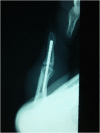Finger shortening for Dupuytren's disease-induced severe PIP joint flexion contracture of the little finger: A report of two cases
- PMID: 33683196
- PMCID: PMC7938730
- DOI: 10.1051/sicotj/2021005
Finger shortening for Dupuytren's disease-induced severe PIP joint flexion contracture of the little finger: A report of two cases
Abstract
When severe proximal interphalangeal (PIP) joint flexion contracture is induced in the little finger by Dupuytren's disease, it interferes with activities of daily living. To extend the little finger, open fasciectomy is selected as a general treatment method. However, postoperative complications have been frequently reported. To solve these problems, finger shortening was undertaken. In this study, we treated two cases of Dupuytren's disease manifesting severe PIP joint flexion contracture of the little finger with finger shortening by proximodistal interphalangeal (PDIP) fusion in which the middle phalanx is resected and the residual distal and proximal phalanges are fused. For flexion contracture of the MP joint, a percutaneous aponeurotomy using an 18G needle was performed to obtain the extended position of the MP joint. Favorable outcomes with high patient satisfaction, including esthetic aspects of retaining the finger with the nail without complication, were achieved. We report this challenging treatment and its discussion.
Keywords: Dupuytren’s disease; Finger shortening; Little finger; Severe PIP joint flexion contracture.
© The Authors, published by EDP Sciences, 2021.
Figures




Similar articles
-
[Severe contracture of the proximal interphalangeal joint in Dupuytren's disease: does capsuloligamentous release improve outcome?].Handchir Mikrochir Plast Chir. 2002 Mar;34(2):123-7. doi: 10.1055/s-2002-32304. Handchir Mikrochir Plast Chir. 2002. PMID: 12073190 German.
-
[Supplementary arthrolysis of the proximal interphalangeal joint of fingers in surgical treatment of Dupuytren's contracture].Oper Orthop Traumatol. 2016 Feb;28(1):4-11. doi: 10.1007/s00064-015-0427-3. Epub 2015 Dec 2. Oper Orthop Traumatol. 2016. PMID: 26631405 Clinical Trial. German.
-
Supplementary arthrolysis of the proximal interphalangeal finger joint in Dupuytren's contracture: primary operation versus revision.Arch Orthop Trauma Surg. 2016 Mar;136(3):435-9. doi: 10.1007/s00402-015-2380-x. Epub 2015 Dec 29. Arch Orthop Trauma Surg. 2016. PMID: 26714475
-
[Operative treatment of Dupuytren's contracture : Arthrolysis of the proximal interphalangeal finger joint].Orthopade. 2017 Apr;46(4):328-335. doi: 10.1007/s00132-017-3387-5. Orthopade. 2017. PMID: 28175957 Review. German.
-
Cost-effectiveness in the management of Dupuytren's contracture. A Canadian cost-utility analysis of current and future management strategies.Bone Joint J. 2013 Aug;95-B(8):1094-100. doi: 10.1302/0301-620X.95B8.31822. Bone Joint J. 2013. PMID: 23908426 Review.
References
-
- Blazar PE, Garon MT (2015) Ray resections of the fingers: Indications, techniques, and outcomes. J Am Acad Orthop Surg 23, 476–484. - PubMed
-
- Vesper US, Mehling IM, Arsalan-Werner A, Sauerbier M (2017) Primary intervention in Dupuytren’s disease. Orthopade 46, 336–341. - PubMed
-
- Eberlin KR, Mudgal CS (2018) Complications of treatment for Dupuytren disease. Hand Clin 34, 387–394. - PubMed
Publication types
LinkOut - more resources
Full Text Sources
Other Literature Sources
